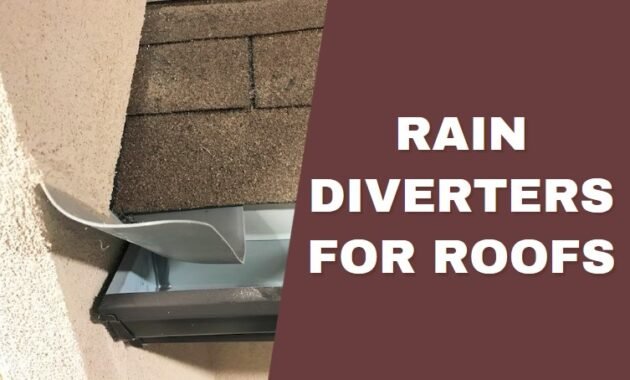Rain diverters for roofs are vital as they effectively direct water away from your home, safeguarding the siding and maintaining dry walls. However, diverter installation may sometimes be challenging due to a home’s architectural constraints. In such cases, functional or decorative alternatives may be necessary.
What are Rain Diverters?
Rain diverters, also known as water diverters, are metal strips strategically placed under the roof shingles to redirect rainwater sideways. These devices are essential in collecting and guiding water away from entryways, preventing it from pouring directly over doors and windows. They are made in either a J or an L profile.

Despite their superiority over gutter replacements, rain diverters also have several disadvantages. Diverters especially give ice dams a footing in colder areas. They may also be ugly, particularly given how they tend to disrupt the uniformity of a roof’s look.
However, rain diverters might be fantastic if they don’t bother you. They’ll be able to provide your walls and siding with some protection, preventing the need for siding repair in the future.
The Purpose of Rain Diverter
- Moving Water Sideways
The primary purpose of a rain diverter is to channel rainwater away from critical areas of your home. These devices, easy to install and designed as shaped metal strips positioned beneath the roof’s surface, ensure that water is effectively redirected, enhancing the home’s protection against water damage.
Homes often place these over their entrance doors. When it rains, the diverters keep water from entering the house by diverting it away from the doorways.
- Rain Diverter Profiles
Pre-fabricated rain diverters are available in either the J-profile or the L-profile. Under the shingle course above, they are screwed down and sealed with sealant. The course slopes and allows proper drainage with the tapered top edge tucked into the ground.
A thicker profile on each panel might stiffen it. You require a qualified roofer to assist you in installing them for this.
Rain diverters for roofs are not only functional in redirecting water but also play a crucial role in protecting the structural integrity of your home. By diverting water, they help prevent the formation of puddles that can lead to leaks and water damage.
Additionally, these diverters can be instrumental in preventing the buildup of ice dams in colder climates, further safeguarding your roof from weather-related damage.
How to Install a Rain Diverter
If you’re planning to install a rain diverter but are unsure of the process, start by gathering the necessary tools listed below. This preparation will facilitate a smoother installation process, allowing for efficient placement and securing of the rain diverter on your roof.
- Flat pry bar
- Aviation snips
- Hammer
- Caulk gun
- Ladder
Your roof rain diverters, roofing nails, and silicone caulk are a few supplies you must have in addition to the necessary equipment.
- Install your ladder so you can access the roof.
- To remove obstructed roof shingles, use a flat pry bar.
- Lift the shingles, slide the diverter in, and secure with roofing nails, being sure to tuck each nail under a shingle.
- Apply a 1/4-inch thick bead of silicone caulk on the bottom of the drip edge.
- Use caulk to secure each shingle.
- Use a garden hose to spray water over the roof to evaluate the rain diverter’s performance.
Your project is complete if your roof diverters pass the test.
Read also: Is Moss Harmful to Roof Shingles?
Tips On Installing Rain Diverter for Shingle Roof
To install rain diverters for shingle roofs, you’ll need to carefully loosen and lift a few shingles using a pry bar. Ensuring gentle handling will prevent damage to the shingles, making the installation process smoother and more efficient.
Please take caution not to peel or tear any obstinate shingles. Engaging a specialist for this work is preferable because it can require some accuracy.
Additionally, the rain diverter for a flat roof needs to be fastened. The diverter’s back should be where the nails are placed so the shingles will cover the nail holes. Finally, experts advise coating the nails with liquid cement to stop leaks.
When installing rain diverters, it’s important to consider your roof type. For instance, the installation process might differ slightly for roofs with different materials or slopes. It’s also essential to ensure that the diverter is positioned correctly to collect and channel water efficiently without causing any obstruction to the roof’s drainage system.
Bottom Line
After reading this manual, you should understand how to install rain diverters for roofs. Even though installing a rain diverter may appear complicated, you can complete the task in about 20 minutes if you follow the proper procedures.
Read also: How to Repair Granular Loss on Roof
Gutter installation is crucial in addition to rain diverters, as was previously stated. With both, you can protect your property from freely falling rain.


